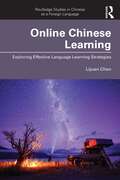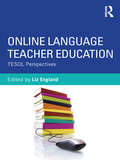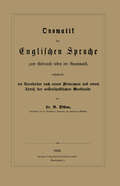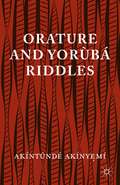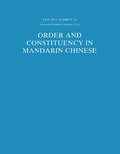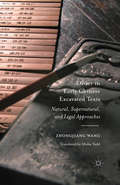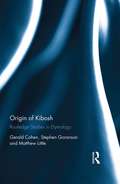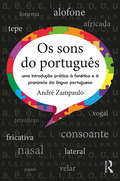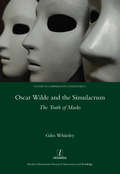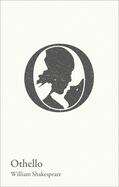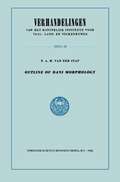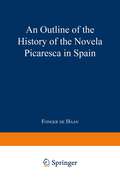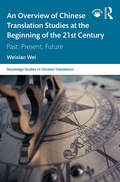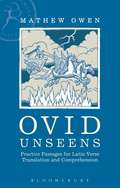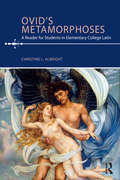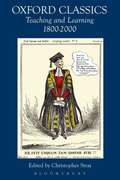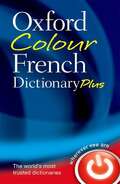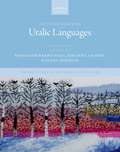- Table View
- List View
Online Chinese Learning: Exploring Effective Language Learning Strategies (Routledge Studies in Chinese as a Foreign Language)
by Lijuan ChenOnline Chinese Learning aims to investigate the types of language learning strategies (LLSs) that online Chinese learners use across asynchronous and synchronous learning environments in different learning contexts.This book examines how the use of language learning strategies by online Chinese learners is influenced by the interactants; the characteristics of the specific learning context; and selected individual learner characteristics. This book will provide: (1) new and detailed information about students’ LLS use in online Chinese learning; (2) insights into how individual students adopt LLSs and technological tools to solve learning problems in various learning contexts; (3) an exploration of factors influencing LLS use; and (4) recommendations regarding LLS adoption, use, and training.This book will be a valuable resource for university instructors in languages, language teaching methods, and second language acquisition, as well as researchers in languages, linguistics, and language learning and teaching.
Online Language Teacher Education: TESOL Perspectives
by Liz EnglandMore and more, ESL/EFL teachers are required by their employers to obtain a Master’s degree in TESOL. Thousands of ESL/EFL teachers are acquiring professional skills and knowledge through online and distance education instructional models. Filling a growing need and making an important contribution, this book is a forerunner in addressing some of the issues and problems for online distance learning and instructional delivery in TESOL and applied linguistics departments in universities around the world. Carefully addressing the complexity of the field, this volume includes primary research and case studies of programs where a variety of online distance models are used. Structured in a logical sequence, the readable and accessible content represents the collected expertise of leading language teacher educators. Each chapter brings the reader a better understanding and ability to apply knowledge about online distance TESOL education.
Online Language Teacher Education: TESOL Perspectives
by Liz EnglandMore and more, ESL/EFL teachers are required by their employers to obtain a Master’s degree in TESOL. Thousands of ESL/EFL teachers are acquiring professional skills and knowledge through online and distance education instructional models. Filling a growing need and making an important contribution, this book is a forerunner in addressing some of the issues and problems for online distance learning and instructional delivery in TESOL and applied linguistics departments in universities around the world. Carefully addressing the complexity of the field, this volume includes primary research and case studies of programs where a variety of online distance models are used. Structured in a logical sequence, the readable and accessible content represents the collected expertise of leading language teacher educators. Each chapter brings the reader a better understanding and ability to apply knowledge about online distance TESOL education.
Onomatik der Englischen Sprache zum Gebrauche neben der Grammatik, enthaltend ein Vocabular nach neuen Principien und einen Abriß der wissenschaftlichen Wortkunde
by R. DihmOrature and Yoruba Riddles
by Akintunde Akinyemi A. AkinyemeOrature and Yorùbá Riddles takes readers into the hitherto unexplored undercurrents of riddles in Africa. Because of its oral and all too often ephemeral nature, riddles have escaped close scrutiny from scholars. The strength of the Yorùbá as the focus of this study is impressive indeed: a major ethnic group in Africa, with established connections with the black diaspora in North America and the Caribean; a rich oral and written culture; a large and diverse population; and an integrated rural-urban society. The book is divided into six chapters for readers' convenience. When read in sequence, the book provides a comprehensive, holistic sense of Yorùbá creativity where riddles are concerned. At the same time, the book is conceived in a way that each chapter could be read individually. Therefore, those readers seeking understanding of a specific type of riddle may target a single chapter appearing most relevant to her/his curiosity.
Order and Constituency in Mandarin Chinese (Studies in Natural Language and Linguistic Theory #19)
by Audrey Li Yen HuiRecent developments in generative grammar have been very stimulating. The current theory defines a small set of principles that apply to all human languages. Efforts have been made to demonstrate the adequacy of this theory for a wide range of languages. We thus see an interesting interface of theory and empirical data: the study of natural languages contributes to defining the properties of Universal Grammar and the predictions of the theory help in uncovering generalizations regarding natural languages. This book aims to add to this exciting development by showing how the analysis of Mandarin Chinese constituent structures helps to define Case Theory and how interesting generalizations concerning Chinese grammar are uncovered through verification of the theoretical predictions. Starting from the inadequacy of work by Koopman, Li, and Travis on the effect of Case directionality on word order, the book shows that a detailed study of Chinese constituent structures allows us to reduce the phrase structure component to a minimal statement concerning the position of the head in a given phrase. It argues that in a given language the constituent structures can be adequately captured by the interaction of Case Theory, Theta Theory, Government Theory, and X Theory. Long standing controversies concerning Chinese basic word order are resolved by showing that underlying word order generalizations can differ from surface word order generalizations.
Order in Early Chinese Excavated Texts: Natural, Supernatural, and Legal Approaches
by Zhongjiang WangRecently discovered ancient silk and bamboo manuscripts have transformed our understanding of classical Chinese thought. In this book, Wang Zhongjiang closely examines these texts and, by parsing the complex divergence between ancient and modern Chinese records, reveals early Chinese philosophy to be much richer and more complex than we ever imagined. As numerous and varied cosmologies sprang up in this cradle of civilization, beliefs in the predictable movements of nature merged with faith in gods and their divine punishments. Slowly, powerful spirits and gods were stripped of their potency as nature's constant order awakened people to the possibility of universal laws, and those laws finally gave birth to an ideally conceived community, objectively managed and rationally ordered.
Origin of Kibosh: Routledge Studies in Etymology
by Gerald Cohen Stephen Goranson Matthew LittleThis is an etymological study of the origins of the word kibosh, which has long been one of the great mysteries of the English language. Unconvincing derivations have been suggested from Yiddish to Gaelic and Italian, and thus far consensus among lexicographers has leaned toward referencing the word as ‘origin unknown’. In this study, the authors present convincing and important new evidence in favour of the derivation of kibosh from the word for a fearsome Middle Eastern whip, known as the kurbash. This monograph is one of the most significant etymological works directed at a single phrase. It is the gold standard on deep-drill, focused and exhaustive single-word lexicography and will be of interest to lexicographers and linguists in the relevant fields.
Origin of Kibosh: Routledge Studies in Etymology
by Gerald Cohen Stephen Goranson Matthew LittleThis is an etymological study of the origins of the word kibosh, which has long been one of the great mysteries of the English language. Unconvincing derivations have been suggested from Yiddish to Gaelic and Italian, and thus far consensus among lexicographers has leaned toward referencing the word as ‘origin unknown’. In this study, the authors present convincing and important new evidence in favour of the derivation of kibosh from the word for a fearsome Middle Eastern whip, known as the kurbash. This monograph is one of the most significant etymological works directed at a single phrase. It is the gold standard on deep-drill, focused and exhaustive single-word lexicography and will be of interest to lexicographers and linguists in the relevant fields.
Os sons do português: uma introdução prática à fonética e à pronúncia da língua portuguesa (3D Photorealistic Rendering)
by André ZampauloOs sons do português is a practical introduction to the phonetics and pronunciation of Portuguese, with a focus on the sound patterns of Portuguese from a non-theoretical perspective. Written entirely in Portuguese, the book addresses the correspondence between sounds and spelling rules, syllabic structure and stress patterns of the language, as well as an introduction to phonetic notation, terminology, and transcription. Key features: Easy-to-follow organization, with gradual development from introductory to advanced material to build on students’ pre-existing knowledge of Portuguese pronunciation A range of activities, including descriptive and audio-visual exercises based on examples from cultural products of Portuguese-speaking communities Illustrative descriptions and audio-visual samples of the main dialects of the Lusophone world, particularly from Brazil and Portugal Online access to audio files that accompany the text This is an ideal resource for non-native and heritage speakers of Portuguese at level B2 – C2 of the Common European Framework for Languages, and Intermediate High – Advanced High on the ACTFL proficiency scales.
Oscar Wilde and the Simulacrum: The Truth of Masks
by Giles WhiteleyOscar Wilde is more than a name, more than an author. From precocious Oxford undergraduate to cause celebre of the West End of the 1890s, to infamous criminal, the proper name Wilde has become an event in the history of literature and culture. Taking Wilde seriously as a philosopher in his own right, Whiteley's groundbreaking book places his texts into their philosophical context in order to show how Wilde broke from his peers, and in particular from idealism, and challenges recent neo-historicist readings of Wilde which seem content to limit his irruptive power. Using the paradoxical concept of the simulacrum to resituate Wilde's work in relation to both his precursors and his contemporaries, Whiteley's study reads Wilde through Deleuze and postmodern philosophical commentary on the simulacrum. In a series of striking juxtapositions, Whiteley challenges us to rethink both Oscar Wilde's aesthetics and his philosophy, to take seriously both the man and the mask. His philosophy of masks is revealed to figure a truth of a different kind - the simulacra through which Wilde begins to develop and formulate a mature philosophy that constitutes an ethics of joy.
Oscar Wilde and the Simulacrum: The Truth of Masks
by Giles WhiteleyOscar Wilde is more than a name, more than an author. From precocious Oxford undergraduate to cause celebre of the West End of the 1890s, to infamous criminal, the proper name Wilde has become an event in the history of literature and culture. Taking Wilde seriously as a philosopher in his own right, Whiteley's groundbreaking book places his texts into their philosophical context in order to show how Wilde broke from his peers, and in particular from idealism, and challenges recent neo-historicist readings of Wilde which seem content to limit his irruptive power. Using the paradoxical concept of the simulacrum to resituate Wilde's work in relation to both his precursors and his contemporaries, Whiteley's study reads Wilde through Deleuze and postmodern philosophical commentary on the simulacrum. In a series of striking juxtapositions, Whiteley challenges us to rethink both Oscar Wilde's aesthetics and his philosophy, to take seriously both the man and the mask. His philosophy of masks is revealed to figure a truth of a different kind - the simulacra through which Wilde begins to develop and formulate a mature philosophy that constitutes an ethics of joy.
OTHELLO: A-level and GCSE 9-1 set text student edition (PDF)
by William ShakespeareThis edition of Othello is perfect for A-level and GCSE 9-1 students, with the complete play in an accessible format, on-page notes, introduction setting the context, timeline, character and theme indexes. Affordable high quality complete play for Othello Demystify vocabulary with notes on the page and concise commentary Set the scene with perfectly pitched introductions that introduce key contexts, concerns and stylistic features, and examine different performances and interpretations Recall plot summaries at the beginning of each scene Support GCSE and A Level revision and essay writing with theme and character indexes Help with social, historical and literary context with the bespoke timeline of Shakespeare’s life and times
Outline of Dani Morphology (Verhandelingen van het Koninklijk Instituut voor Taal-, Land- en Volkenkunde #48)
by P.A.M. van van der StapAn Overview of Chinese Translation Studies at the Beginning of the 21st Century: Past, Present, Future (Routledge Studies in Chinese Translation)
by Weixiao WeiAn Overview of Chinese Translation Studies at the Beginning of the 21st Century presents and analyses over 100,000 bibliographic notes contained within a large academic database focusing on translation within China. Exploring Chinese translation studies two decades before and after the year 2000, the book will introduce aspects of theory, culture, strategy, register, genre, and context to the field of translation in China, and will also take into account the impact of technology, education, and research within this field. Aimed at postgraduate students and researchers of translation studies, the focus of An Overview of Chinese Translation Studies at the Beginning of the 21st Century is the theory and practice of translation studies within a fast-paced and growing academic discipline.
An Overview of Chinese Translation Studies at the Beginning of the 21st Century: Past, Present, Future (Routledge Studies in Chinese Translation)
by Weixiao WeiAn Overview of Chinese Translation Studies at the Beginning of the 21st Century presents and analyses over 100,000 bibliographic notes contained within a large academic database focusing on translation within China. Exploring Chinese translation studies two decades before and after the year 2000, the book will introduce aspects of theory, culture, strategy, register, genre, and context to the field of translation in China, and will also take into account the impact of technology, education, and research within this field. Aimed at postgraduate students and researchers of translation studies, the focus of An Overview of Chinese Translation Studies at the Beginning of the 21st Century is the theory and practice of translation studies within a fast-paced and growing academic discipline.
Ovid Unseens: Practice Passages for Latin Verse Translation and Comprehension
by Mathew OwenOvid Unseens provides a bank of 80 practice passages of Latin verse, half elegiac and half hexameter.Taken from across Ovid's works, including the Metamorphoses, Fasti, Heroides, Amores and Tristia, the passages help build students' knowledge and confidence in a notoriously difficult element of Latin language learning. Every passage begins with an introduction, outlining the basic story and theme of the passage, followed by a 'lead-in' sentence, paraphrasing the few lines before the passage begins. The first set of passages are translation exercises of 12-16 lines, each accompanied by a Discendum box which highlights a key feature of poetic Latin, equipping students further with the skills to tackle ever more difficult verse passages at first sight. These are followed by longer passages with scansion exercises and questions on comprehension and stylistic analysis, replicating unseen verse exam questions in full. The comprehensive introduction provides an overview of Ovid's life and work, an account of some of the stylistic features of his poetry, and practical help in the form of tips on how to approach the more challenging lines of Latin verse and produce a fluent translation. A step-by-step guide to scansion, with practice exercises and answers, covers the essential principles for scanning lines of Latin verse, from the basics of understanding syllables, feet and types of metres, to coping with elision and caesurae. A guideline verse vocabulary list is provided which covers words particularly common in Ovid's works. Broken down into small 'checklists', each corresponding to a group of four passages, the vocabulary is learnt cumulatively and as it is encountered.
Ovid Unseens: Practice Passages for Latin Verse Translation and Comprehension
by Mathew OwenOvid Unseens provides a bank of 80 practice passages of Latin verse, half elegiac and half hexameter.Taken from across Ovid's works, including the Metamorphoses, Fasti, Heroides, Amores and Tristia, the passages help build students' knowledge and confidence in a notoriously difficult element of Latin language learning. Every passage begins with an introduction, outlining the basic story and theme of the passage, followed by a 'lead-in' sentence, paraphrasing the few lines before the passage begins. The first set of passages are translation exercises of 12-16 lines, each accompanied by a Discendum box which highlights a key feature of poetic Latin, equipping students further with the skills to tackle ever more difficult verse passages at first sight. These are followed by longer passages with scansion exercises and questions on comprehension and stylistic analysis, replicating unseen verse exam questions in full. The comprehensive introduction provides an overview of Ovid's life and work, an account of some of the stylistic features of his poetry, and practical help in the form of tips on how to approach the more challenging lines of Latin verse and produce a fluent translation. A step-by-step guide to scansion, with practice exercises and answers, covers the essential principles for scanning lines of Latin verse, from the basics of understanding syllables, feet and types of metres, to coping with elision and caesurae. A guideline verse vocabulary list is provided which covers words particularly common in Ovid's works. Broken down into small 'checklists', each corresponding to a group of four passages, the vocabulary is learnt cumulatively and as it is encountered.
Ovid's Metamorphoses: A Reader for Students in Elementary College Latin
by Christine L. AlbrightOvid’s Metamorphoses is a Latin reader designed to partner existing elementary Latin textbooks. The book features thirty compelling stories, graduated in difficulty and adapted from Ovid’s epic Metamorphoses into prose. The original poem contains many different stories united thematically by the transformation which occurs in all of them; the epic features romance, seduction, humour, violence, monsters, and misbehaving gods. Each chapter contains: a Latin passage adapted from the epic an accompanying vocabulary list a short commentary to help with translation a concise review of the specific grammar covered a brief comment on a literary aspect of the poem, or featured myth. A free companion website, offering a wealth of additional resources, including worksheets, flashcards, additional notes for each chapter, and audio, is available at www.routledge.com/cw/albright. Suitable for college students studying Latin at the elementary level, Ovid’s Metamorphoses is designed to be used alongside elementary Latin textbooks. Preserving Ovid’s language and highly vivid descriptions, this reader introduces students to the epic masterpiece, allows them to consolidate their understanding of Latin prose, and offers opportunities for literary discussion.
Ovid's Metamorphoses: A Reader for Students in Elementary College Latin
by Christine L. AlbrightOvid’s Metamorphoses is a Latin reader designed to partner existing elementary Latin textbooks. The book features thirty compelling stories, graduated in difficulty and adapted from Ovid’s epic Metamorphoses into prose. The original poem contains many different stories united thematically by the transformation which occurs in all of them; the epic features romance, seduction, humour, violence, monsters, and misbehaving gods. Each chapter contains: a Latin passage adapted from the epic an accompanying vocabulary list a short commentary to help with translation a concise review of the specific grammar covered a brief comment on a literary aspect of the poem, or featured myth. A free companion website, offering a wealth of additional resources, including worksheets, flashcards, additional notes for each chapter, and audio, is available at www.routledge.com/cw/albright. Suitable for college students studying Latin at the elementary level, Ovid’s Metamorphoses is designed to be used alongside elementary Latin textbooks. Preserving Ovid’s language and highly vivid descriptions, this reader introduces students to the epic masterpiece, allows them to consolidate their understanding of Latin prose, and offers opportunities for literary discussion.
Oxford Classics: Teaching and Learning 1800-2000
by Christopher StrayOxford, the home of lost causes, the epitome of the world of medieval and renaissance learning in Britain, has always fascinated at a variety of levels: social, institutional, cultural. Its rival, Cambridge, was long dominated by mathematics, while Oxford's leading study was Classics. In this pioneering book, 16 leading authorities explore a variety of aspects of Oxford Classics in the last two hundred years: curriculum, teaching and learning, scholarly style, publishing, gender and social exclusion and the impact of German scholarship. Greats (Literae Humaniores) is the most celebrated classical course in the world: here its early days in the mid-19th century and its reform in the late 20th are discussed, in the latter case by those intimately involved with the reforms. An opening chapter sets the scene by comparing Oxford with Cambridge Classics, and several old favourites are revisited, including such familiar Oxford products as Liddell and Scott's "Greek-English Lexicon", the "Oxford Classical Texts", and Zimmern's "Greek Commonwealth". The book as a whole offers a pioneering, wide-ranging survey of Classics in Oxford.
Oxford Classics: Teaching and Learning 1800-2000
by Christopher StrayOxford, the home of lost causes, the epitome of the world of medieval and renaissance learning in Britain, has always fascinated at a variety of levels: social, institutional, cultural. Its rival, Cambridge, was long dominated by mathematics, while Oxford's leading study was Classics. In this pioneering book, 16 leading authorities explore a variety of aspects of Oxford Classics in the last two hundred years: curriculum, teaching and learning, scholarly style, publishing, gender and social exclusion and the impact of German scholarship. Greats (Literae Humaniores) is the most celebrated classical course in the world: here its early days in the mid-19th century and its reform in the late 20th are discussed, in the latter case by those intimately involved with the reforms. An opening chapter sets the scene by comparing Oxford with Cambridge Classics, and several old favourites are revisited, including such familiar Oxford products as Liddell and Scott's "Greek-English Lexicon", the "Oxford Classical Texts", and Zimmern's "Greek Commonwealth". The book as a whole offers a pioneering, wide-ranging survey of Classics in Oxford.
The Oxford Colour French Dictionary Plus (PDF)
by Oxford Dictionaries StaffThis dictionary is an effective and practical reference tool for any student, adult learners, or travellers. It is especially user-friendly, with a colourful design that makes it easy to find the word you are looking for quickly. It also has usage notes, giving you help with tricky and frequently occurring words, verb lists, and grammar notes. The up-to-date centre section helps you build your vocabulary. The main focus of this section is to help you build your vocabulary. We have identified the French words you most need to know, and they are laid out clearly for you here; you will also find them marked with a handy key symbol in the A-Z text of the dictionary. Also included are word games so that you can practise your dictionary skills and learn vocabulary while having fun. The centre section also contains a calendar of holidays and festivals and an updated A-Z guide to French life and culture - ideal for the traveller and for those learning about life in French-speaking countries.
The Oxford Guide to the Uralic Languages (Oxford Guides to the World's Languages)
This volume offers the most comprehensive and wide-ranging treatment available today of the Uralic language family, a group of languages spoken in northern Eurasia. While there is a long history of research into these languages, much of it has been conducted within several disparate national traditions; studies of certain languages and topics are somewhat limited and in many cases outdated. The Oxford Guide to the Uralic Languages brings together leading scholars and junior researchers to offer a comprehensive and up-to-date account of the internal relations and diversity of the Uralic language family, including the outlines of its historical development, and the contacts between Uralic and other languages of Eurasia. The book is divided into three parts. Part I presents the origins and development of the Uralic languages: the initial chapters examine reconstructed Proto-Uralic and its divergence, while later chapters provide surveys of the history and codification of the three Uralic nation-state languages (Hungarian, Finnish, and Estonian) and the Uralic minority languages from Baltic Europe to Siberia. This part also explores questions of endangerment, revitalization, and language policy. The chapters in Part II offer individual structural overviews of the Uralic languages, including a number of understudied minority languages for which no detailed description in English has previously been available. The final part of the book provides cross-Uralic comparative and typological case studies of a range of issues in phonology, morphology, syntax, and the lexicon. The chapters explore a number of topics, such as information structure and clause combining, that have traditionally received very little attention in Uralic studies. The volume will be an essential reference for students and researchers specializing in the Uralic languages and for typologists and comparative linguists more broadly.
